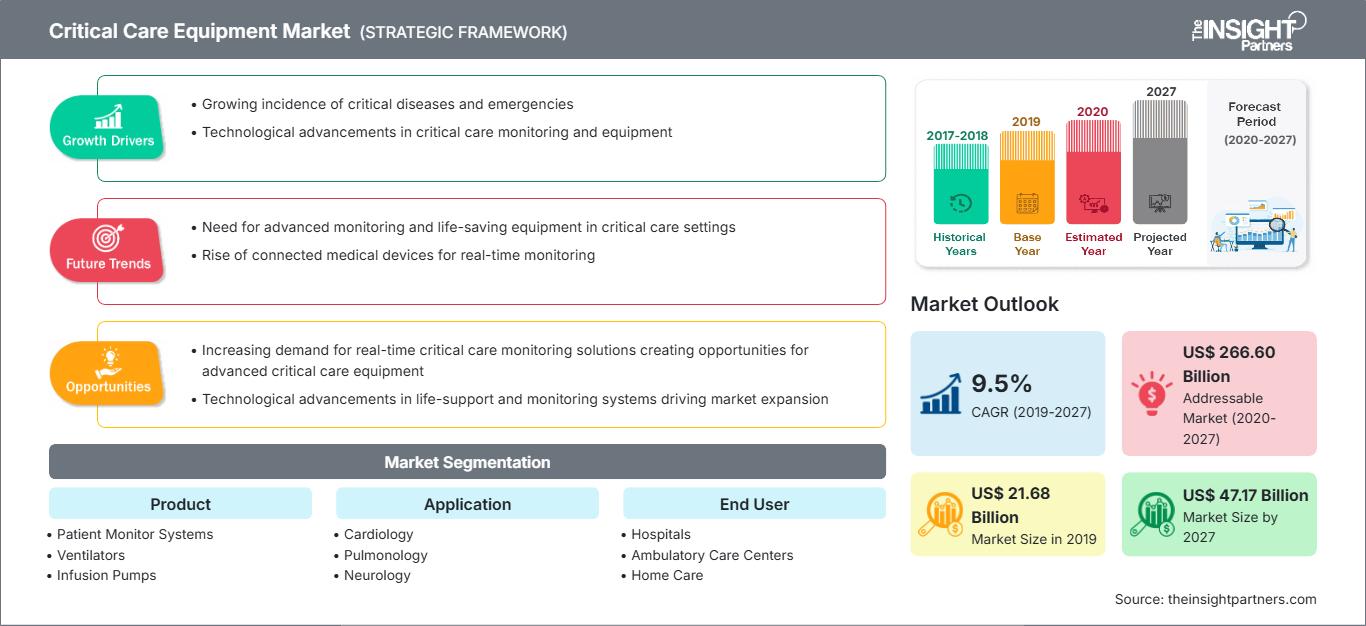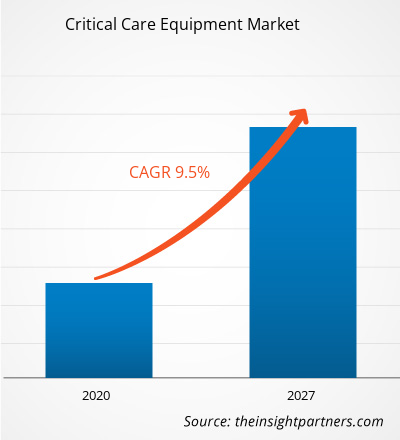Le marché des équipements de soins intensifs était évalué à 21 682,65 millions de dollars américains en 2019 et devrait atteindre 47 171,42 millions de dollars américains d'ici 2027 ; il devrait croître à un TCAC de 9,5 % entre 2020 et 2027.
Un lit de soins intensifs est équipé et doté en personnel pour permettre des soins de niveau USI et fournir une ventilation mécanique ainsi qu'une surveillance invasive. Selon le Centre national d'information sur la biotechnologie, en mai 2020, le Canada étant au plus fort de l'épidémie de COVID-19, le besoin en lits de soins intensifs a dépassé de manière significative, même avec 40 % d'auto-isolement. Le nombre de lits de soins intensifs existants dans chaque région variait de 0,63 à 1,85 pour 10 000 personnes. En supposant un taux d'occupation actuel estimé à 80 %, le nombre de lits de soins intensifs inoccupés disponibles pour les patients atteints de la COVID-19 varierait selon la région entre 0,13 et 0,37 pour 10 000 personnes.
Les patients infectés passent en moyenne 15 jours en soins intensifs. Selon la Société européenne d'anesthésiologie, le nombre de lits de soins intensifs en Italie continue de croître. En Lombardie, avant la propagation du coronavirus, on comptait 140 lits de soins intensifs privés et 500 lits de soins intensifs publics, un chiffre qui est passé à plus de 900 fin mars 2020.
Personnalisez ce rapport en fonction de vos besoins
Vous bénéficierez d’une personnalisation sur n’importe quel rapport - gratuitement - y compris des parties de ce rapport, ou une analyse au niveau du pays, un pack de données Excel, ainsi que de profiter d’offres exceptionnelles et de réductions pour les start-ups et les universités
Marché des équipements de soins intensifs: Perspectives stratégiques

- Obtenez les principales tendances clés du marché de ce rapport.Cet échantillon GRATUIT comprendra une analyse de données, allant des tendances du marché aux estimations et prévisions.
Aperçu du marché : L'augmentation du nombre de lits de soins intensifs dans les pays à forte prévalence de la COVID-19 stimulera la croissance du marché.
Vous bénéficierez d’une personnalisation sur n’importe quel rapport - gratuitement - y compris des parties de ce rapport, ou une analyse au niveau du pays, un pack de données Excel, ainsi que de profiter d’offres exceptionnelles et de réductions pour les start-ups et les universités
Marché des équipements de soins intensifs: Perspectives stratégiques

- Obtenez les principales tendances clés du marché de ce rapport.Cet échantillon GRATUIT comprendra une analyse de données, allant des tendances du marché aux estimations et prévisions.
La COVID-19 a été déclarée pandémie mondiale par l'Organisation mondiale de la santé le 11 mars 2020. Cette nouvelle maladie se caractérise par une baisse du nombre de cas initiaux, suivie d'une explosion des infections dans divers pays. Malgré la mise en place de confinements pour réduire la propagation de la COVID-19, les systèmes de santé de divers pays ont été submergés par la demande d'équipements, tels que des lits de soins intensifs et du matériel de soutien pour traiter les cas graves.
Aperçu des produits
En termes de produits, le segment des systèmes de surveillance des patients détenait la plus grande part de marché en 2019 et devrait conserver son rôle d'actionnaire majeur au cours de la période de prévision. Cependant, le segment des respirateurs devrait enregistrer un TCAC plus élevé sur le marché au cours de la période de prévision.
Aperçu des applications
Sur la base des applications, le marché mondial des équipements de soins intensifs est segmenté en cardiologie, pneumologie, neurologie, orthopédie et autres. Le segment de la cardiologie détenait la plus grande part de marché en 2019, et le segment de la pneumologie devrait enregistrer le TCAC le plus élevé au cours de la période de prévision. Les soins intensifs cardiovasculaires sont la prise en charge systémique des patients atteints de maladies cardiovasculaires (MCV) graves, notamment de maladies vasculaires et de maladies cardiaques. Les MCV comptent parmi les principales causes de décès dans le monde. Par exemple, selon l'Organisation mondiale de la santé, en 2016, environ 17,9 millions de personnes sont décédées de MCV, soit 31 % des décès dans le monde. De même, selon les Centres pour le contrôle et la prévention des maladies, environ 655 000 Américains meurent chaque année de maladies cardiaques. Afin de prévenir les décès dus aux maladies cardiovasculaires, les hôpitaux généraux disposent d'une unité de soins intensifs pour les patients atteints de maladies cardiovasculaires graves, à savoir l'unité de soins intensifs cardiovasculaires (USIC). Les avancées technologiques en cardiologie clinique, telles que les procédures et dispositifs interventionnels intracoronaires et la surveillance hémodynamique invasive, constituent les principales évolutions des soins intensifs pour les maladies cardiovasculaires. Par conséquent, le nombre de patients atteints de maladies cardiovasculaires graves admis en USIC augmente chaque année. Les patients admis en USIC présentent de nombreuses complications, telles qu'une insuffisance respiratoire et une insuffisance rénale. Par conséquent, un personnel médical qualifié est nécessaire pour pratiquer les soins intensifs systémiques.
Les collaborations et les partenariats technologiques entre les acteurs du marché des équipements de soins intensifs pour combler l'écart entre l'offre et la demande devraient jouer un rôle important dans la croissance du marché au cours de la période de prévision.
Aperçu régional du marché des équipements de soins intensifs
Les tendances régionales et les facteurs influençant le marché des équipements de soins intensifs tout au long de la période de prévision ont été analysés en détail par les analystes de The Insight Partners. Cette section aborde également les segments et la géographie du marché des équipements de soins intensifs en Amérique du Nord, en Europe, en Asie-Pacifique, au Moyen-Orient et en Afrique, ainsi qu'en Amérique du Sud et en Amérique centrale.
Portée du rapport sur le marché des équipements de soins intensifs
| Attribut de rapport | Détails |
|---|---|
| Taille du marché en 2019 | US$ 21.68 Billion |
| Taille du marché par 2027 | US$ 47.17 Billion |
| TCAC mondial (2019 - 2027) | 9.5% |
| Données historiques | 2017-2018 |
| Période de prévision | 2020-2027 |
| Segments couverts |
By Produits
|
| Régions et pays couverts | Amérique du Nord
|
| Leaders du marché et profils d'entreprises clés |
|
Densité des acteurs du marché des équipements de soins intensifs : comprendre son impact sur la dynamique commerciale
Le marché des équipements de soins intensifs connaît une croissance rapide, portée par une demande croissante des utilisateurs finaux, due à des facteurs tels que l'évolution des préférences des consommateurs, les avancées technologiques et une meilleure connaissance des avantages des produits. Face à cette demande croissante, les entreprises élargissent leur offre, innovent pour répondre aux besoins des consommateurs et capitalisent sur les nouvelles tendances, ce qui alimente la croissance du marché.

- Obtenez le Marché des équipements de soins intensifs Aperçu des principaux acteurs clés
- Analyse historique (2 ans), année de base, prévision (7 ans) avec TCAC
- Analyse PEST et SWOT
- Taille du marché Valeur / Volume - Mondial, Régional, Pays
- Industrie et paysage concurrentiel
- Ensemble de données Excel
Rapports récents
Rapports connexes
Témoignages
Raison d'acheter
- Prise de décision éclairée
- Compréhension de la dynamique du marché
- Analyse concurrentielle
- Connaissances clients
- Prévisions de marché
- Atténuation des risques
- Planification stratégique
- Justification des investissements
- Identification des marchés émergents
- Amélioration des stratégies marketing
- Amélioration de l'efficacité opérationnelle
- Alignement sur les tendances réglementaires




















 Obtenez un échantillon gratuit pour - Marché des équipements de soins intensifs
Obtenez un échantillon gratuit pour - Marché des équipements de soins intensifs